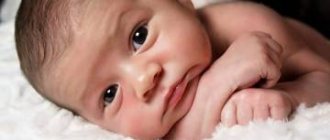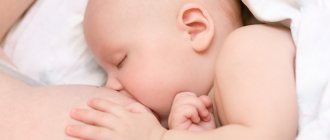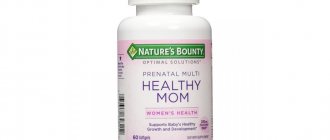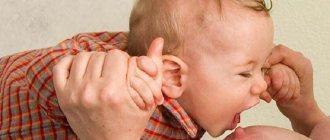Should I give a pacifier to a newborn?
The main task of a pacifier is to satisfy the sucking reflex of a newborn. A lot of rumors and speculation will circulate around this concept. The sucking reflex is formed even before the baby is born.
On an ultrasound, you can often see how a toddler in the mother’s womb sucks a finger, thus, the baby is preparing for independent life, and after birth it can already suck on its mother’s breast on its own.
After birth, the sucking reflex will ensure the normal and proportional development of the jaw apparatus.
The optimal load on the jaws ensures their optimal development - their correct spatial position, the formation of a certain size for the eruption of the entire group of teeth, without crowding.
In newborns, the sucking reflex is pronounced. After feeding, when the baby seems to have already eaten, he still continues to smack his lips, making sucking movements, but after some time he relaxes and falls asleep.
Inexperienced mothers regard this “symptom” as a lack of breast milk or formula.
Pacifier: pros and cons
A pacifier for a baby is a very important component for his development and an assistant in the complete satisfaction of the sucking reflex. In addition, this device will help to quickly calm the baby; the entire sucking reflex is also a kind of sedative. But you can raise a baby without a pacifier without any harm to his health.
Recent studies by dentists and pediatricians have proven the need for proper prescription of pacifiers.
There is a group of children for whom nipples and pacifiers are not indicated - these are breastfed children. And for better stimulation of all growth processes of the maxillofacial apparatus, it is necessary to feed the child according to his demand.
By putting the baby to the breast at his request (about 10 - 12 times), the baby sucks out a sufficient amount of milk, expends the necessary amount of strength, fully satisfies his reflex and falls asleep safely.
In this case, the baby does not need a pacifier, and it is best not to “introduce” the baby to this device. In addition, pediatricians and lactation consultants strictly prohibit combining feeding and a pacifier.
When feeding from a bottle, the baby expends much less effort, and the feeding itself is shorter, i.e. the sucking reflex does not have time to be realized. Therefore, for children who are fully or partially bottle-fed, a pacifier is recommended and necessary.
But as soon as the child falls asleep deeply, the pacifier should be removed from the child's mouth.
Opinion of pediatricians and dentists
Dentists and pediatricians, especially in the person of Dr. Komarovsky. They have repeatedly spoken out about the purpose of the pacifier and the rules for its use so that it is useful and not harmful.
Parents should remember the obvious disadvantages of using pacifiers:
- Material of manufacture. Due to the fact that the material is artificial, the taste and smell are foreign to the child. Breastfeeding is not only the process of saturating the baby with nutrients. But, unfortunately, an artificial nipple cannot give such a feeling as a manifestation of maternal love.
- Lack of adequate hygiene may cause the pacifier to become a potential source of infection.
- The combination of breastfeeding and a pacifier will cause the baby to refuse the breast due to fatigue.
Abuse of a pacifier can provoke the development of malocclusion - protrusion of the front jaw and teeth forward, which disrupts the function of speech production and facial aesthetics.
We teach the baby
Some babies suck their thumbs even before they are born. But this does not mean that as soon as the baby is born, he needs to be given a pacifier. You should not start feeding with formula, because it is much easier to draw milk from a bottle.
Many children refuse to breastfeed after a pacifier. Wait until feeding gets better. At 3-4 or 6-8 weeks, when the schedule is established, you can offer the baby to suck on it between feedings.
Don't use the pacifier as your first defense. Sometimes changing position or rocking can calm a screaming baby. Do not insist if the baby flatly refuses to accept the pacifier.
Weaning from the pacifier
As practice shows, weaning a child off a pacifier is much more difficult than teaching it. The baby is already used to it, he feels calmer this way. But you shouldn’t spend too much time with a pacifier either. This can lead to a number of problems. And the wrong action during weaning can cause psychological trauma.
Doctors recommend starting between 6-9 months. It’s easier at this age, they say. During the day, you can distract the baby by constantly switching his attention, and breastfeed at night. If it doesn’t work out at this age, put the question aside, and at 1.5-2 years old, come back again and try to come to an agreement with the child. Tell a story or remove the pacifier after the baby falls asleep, and the next morning explain that he has already grown up and the pacifier has disappeared.
Be consistent. Remember, you are not the only person whose baby is moving away from the pacifier. Just be close to him. Make sure all other family members—grandparents, nannies—are on the same plan. This will make the process easier.
Pros and cons
Many parents are sure that their child does not need a pacifier - “Why accumulate problems that then need to be dealt with?” At the same time, others experience great relief when using a pacifier.
Experts note that using a pacifier, a newborn refuses breastfeeding. In addition, this can affect the sucking reflex and disrupt feeding patterns. However, “proponents of pacifiers” claim that a properly selected pacifier has absolutely no effect on breastfeeding. Moreover, it calms children with increased excitability.
Which pacifier to choose for a newborn?
If a pacifier is still necessary, then it must be chosen correctly, taking into account many factors.
First of all, it should be adapted according to age, and as the child grows, the pacifier should change. In the pharmacy, almost all manufacturers offer a line of nipples that are intended for babies of a certain age: from birth to six months, from six months to one year, etc.
For convenience, experienced mothers advise having 2–3 pacifiers on hand at once. Fortunately, there are no problems with their acquisition and selection.
In any pharmacy you can find nipples made of various materials, with or without additional functions.
Dentists and pediatricians advise before choosing to pay attention to the material of the nipple - latex or silicone. When choosing a material, first of all, you need to pay attention to natural material.
It is best to give preference to latex, which, in comparison with silicone, is softer and less durable.
If a child begins to teethe, then it is best to abandon latex nipples. These nipples are best suited for newborns, weak and premature babies.
Silicone is a completely synthetic material, such a nipple will be elastic, elastic and will last longer than latex. Therefore, silicone nipples are intended for healthy, strong babies with a developed sucking reflex.
In addition to the size and material, you need to pay attention to the shape of the papilla. Today, there are two options on the market:
- Anatomical - with a flattened elliptical or elongated papilla.
- Orthodontic – the papilla is oblique. It is believed that an orthodontic pacifier is more conveniently and correctly located in the oral cavity, and will resemble the process of grasping and sucking on a mother’s breast.
Hygiene
- Once you've chosen your favorite pacifier, keep a few identical backups on hand.
- Keep them clean in a separate jar or box.
- After falling on the floor or the ground, remove it. There is no need to lick the pacifier yourself; your mouth is not the most sterile place. And up to 6 months, the child has a weak immune system.
- Boil or wash in the dishwasher.
- After six months, falling pacifiers can simply be washed with soap or doused with boiling water.
- Don't dip into sweets.
Replace pacifiers as often as possible and use according to the age of your little one. And if it suddenly breaks or tears, be sure to replace it with a new one, because a child may choke.
Doctor Komarovsky's opinion
To prevent your baby from sucking his finger, you need a pacifier, but if the baby spits it out, you should not insist. Listen to your child, if he wants to suck, let him suck, but you shouldn’t specially train your baby.
No one can say 100% whether evil is a dummy or good. The truth is somewhere in the middle - and your baby will tell you the correct answer.
Having a pacifier as a helper in the house is wonderful. And if she is not a friend, but an enemy, say goodbye. After all, having lost a pacifier, a child is so upset that parents see no other way out but to urgently replace the accessory. And it doesn’t matter at all at what cost. Many mothers, even in the middle of the night, look for 24-hour pharmacies and send their father-messenger for the treasured miracle remedy.
Which pacifiers are best for newborns?
Reviews from parents and the pediatric dentist made it possible to rank the most popular models.
Pacifier Nuk (Nuk)
A German-made pacifier is orthopedic in shape, with a flattened papilla and a recess that will prevent the pacifier from falling out of the baby’s mouth.
The soft and flexible nipple puts virtually no pressure on the mouth and teeth. A special depression on the papilla leaves more space for the tongue, facilitating its movement. The special natural shape resembles the mother's nipple, and for sucking the pacifier the jaw ratio is the same as when sucking the pacifier.
Obvious advantages will be the presence of an air valve, the correct shape, which is the prevention of orthodontic pathologies, and the choice of materials.
The only downside is the pricing policy.
Pigeon pacifier
Made in Japan, best suited for babies and children up to four months.
It has an unusual orthodontic shape - flattened in the middle part. This is just the ideal price-quality ratio.
The obvious advantage will be the inexpensive price, beautiful design and interesting design that kids will like.
Avent pacifier (Philips Avent)
It is the best-selling product among silicone products. This is a classic version of pacifiers that have six holes for ventilation.
This is one of the safest types of pacifiers, because... does not put pressure on the sky. The advantages will be a huge selection by age, completely different designs, and the presence of a protective cap included.
The disadvantages are that the shape is not entirely correct, making it difficult to hold the pacifier in the child’s mouth; due to the presence of ventilation holes, moisture can enter the pacifier itself.
Chicco pacifier
Soft but resilient, durable and flexible.
Latex nipples quickly adapt to the baby's temperature.
The pacifier belongs to the orthodontic class.
Chicco pacifiers are easy to clean and can be boiled and steamed.
All the disadvantages of the pacifier lie precisely in the material of manufacture; latex is far from the most durable material.
Bibi pacifier
These are pacifiers for creative babies, as modern parents say - a cool pacifier. Characterized by durability and unusual design.
The pacifier is made of two-component silicone, which is durable and safe. The set includes a special holder for an open nipple and a case.
Pros: this is a cherry pacifier designed for large babies (can be adjusted to size), the surface of the pacifier is equipped with fun and bright inscriptions that attract children's attention and do not wear off. Like the Avent pacifier, there are two options - day and night (glows in the dark).
The disadvantages will be the expensive price and the lack of ventilation holes.
Canpol Babies pacifiers
Polish manufacturer offering high-quality and comfortable pacifiers of anatomical shape. Nipples can be made of different materials: silicone or latex.
Among the advantages are the presence of an air valve, an affordable price and a huge selection of designs. Tommee Tippee pacifiers offer a wide range of different options. These are orthodontic pacifiers that can be selected according to age.
Special holes on the mouthpiece will promote normal air circulation and prevent skin diseases.
Selecting a pacifier
The best pacifier is the one your baby chooses. Therefore, before you buy a dozen of one brand, take several, but from different manufacturers.
Rely on the important thing - the continuation of the baby’s physical development. It is better to use nipples that have ventilation. This allows air to pass well, which will make it much easier to stay in the baby's mouth.
Form
- Classic - the most common old-style nipple. It is larger than modern ones, but it completely replicates the mother’s breasts, especially the latex accessory. The baby easily sucks the small round papilla and feels calmer, since he practically does not feel the difference.
- Anatomical. Its difference is in the shape of the papilla. It is oblong and slightly flattened. This allows the pressure to be distributed across the palate. In addition, this series has an age range, which makes it possible to use it as the child grows up.
- Orthodontic. At first glance, the nipple is very similar to a regular one, but if you look closely, you can see that its nipple is slightly beveled and flattened. It was created taking into account the structure of the maxillofacial system. Includes protective disc and holder ring. Suitable for children of all ages. Helps premature babies develop the sucking reflex.
- Orthopedic - a completely new specimen. The nipple is drop-shaped and takes up very little space in the baby's mouth. Includes an air vent valve to reduce pressure on baby's palate. Thanks to this, the risk of tooth deformation is minimal. Helps form the correct bite.
- A pacifier with a protective disc is equipped with a wide base that prevents the baby from swallowing it. The disc has two holes on the sides or pimples. This protects against drool buildup and further irritation.
Pacifier size
Generally accepted classification:
- A - 0-6 months.
- B - 6-18 months.
- C - 18 months. and older.
When choosing a particular pacifier, pay attention to the manufacturer's recommendations. After all, their divisions may differ from generally accepted norms. Don’t forget that the size of the pacifier should grow with your little one. The amount of food he will receive directly depends on this.
Deciding on the material
- The rubber one is impractical and short-lived, a poorly proven pacifier that is finally becoming a thing of the past. Its only advantage can be seen at the moment of teething. And then, you should be wary of diathesis.
- Made of latex - soft and elastic, due to the fact that it is made of rubber. Natural nipples are well suited for babies born prematurely. They have a light brown or transparent color. The disadvantages are that they wear out quickly, darken from the sun and, alas, can cause allergies.
- Silicone - elastic, colorless and odorless. More resistant to boiling and does not cause allergies. Cons: very hard, may affect the growth of baby teeth. So if the choice fell on it, use it long before they appear.
Pay attention to the plastic the nipple is made of. An ideal item should be free of BPA, parabens, PVC and phthalates. Many manufacturers use artificial colors and chemical softeners - this is harmful to the child.
Try to choose a pacifier with a solid frame to prevent breakage and ingestion of small particles.
Baby pacifier: rules of use
The main thing is that the pacifier for newborns is safe; for this it is extremely important to follow basic hygiene rules. The silicone pacifier should be changed every one and a half months, and the latex pacifier at least every 3 months.
At least once a day, the pacifier must be disinfected - boiling. For greater safety, the nipple should have a protective disc and cap.
To prevent the pacifier from getting lost and the baby not being able to swallow it, the pacifier must be attached to a special protective disk, which must be wide enough. The disk cannot consist of many parts - it must be monolithic.
The disk itself should have ventilation holes for air circulation. In addition, you must follow the basic rules for its use:
- Change the pacifier according to its service life; even a regularly sterilized pacifier should be replaced with a new one no later than 6–8 weeks of use;
- If the pacifier is damaged (scratches, holes, abrasions), it must be thrown away;
- It is forbidden to leave the pacifier exposed to sunlight or near heating devices;
- To store the pacifier, you must use a special case.











